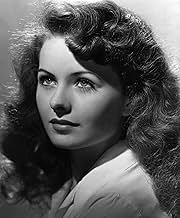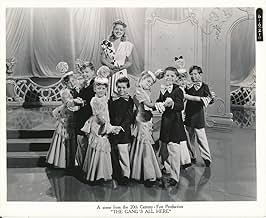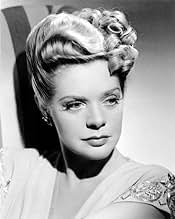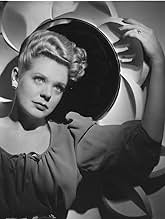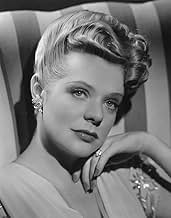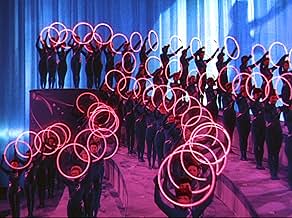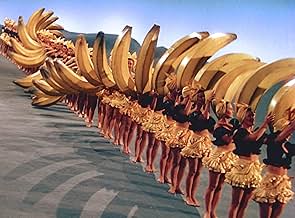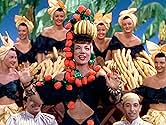NOTE IMDb
6,6/10
2,2 k
MA NOTE
Ajouter une intrigue dans votre langueA soldier falls for a chorus girl and then experiences trouble when he is posted to the Pacific.A soldier falls for a chorus girl and then experiences trouble when he is posted to the Pacific.A soldier falls for a chorus girl and then experiences trouble when he is posted to the Pacific.
- Réalisation
- Scénario
- Casting principal
- Nommé pour 1 Oscar
- 2 victoires et 1 nomination au total
Benny Goodman and His Orchestra
- Benny Goodman's Orchestra
- (as Benny Goodman Orchestra)
Don Anderson
- Club New Yorker Patron
- (non crédité)
Leon Belasco
- Waiter
- (non crédité)
Brooks Benedict
- Club New Yorker Patron
- (non crédité)
Lee Bennett
- Club New Yorker Patron
- (non crédité)
William A. Boardway
- Club New Yorker Patron
- (non crédité)
Avis à la une
I'll get to the plot of "The Gang's All Here" in a minute, because the plot isn't the most memorable part of this movie. The most memorable part is the bananas.
About 20 minutes into the movie, a towering hat of Technicolor fruit appears on the screen, followed by its owner--'40s "Brazilian bombshell" Carmen Miranda. She proceeds to do a number called "The Lady in the Tutti-Frutti Hat," accompanied by chorus girls who bear bananas. Six-foot-tall bananas that continuously droop and sprout until number's end, when the chorus girls, worn out by the burden of this mutated fruit, lay down for a long siesta on a stage dressed up like an island.
There's a reason this number occurs so early on: It takes you the rest of the movie to convince yourself you actually saw this in a 1943 movie.
But then, this is Busby Berkeley, a director who staged his musical numbers as though he was declaring war. And next to kitsch, war is pretty much the motivator here.
The wafer-thin story involves Andy (James Ellison), a soldier who woos and wins Edie (Alice Faye), a canteen dancer, the night before Andy goes off to World War Two. In what seems an instant, Andy gets decorated and returned home to a victory party thrown by the family of Andy's childhood sweetheart and fiancee--who, unfortunately for Edie, is not Edie.
Will the heartbreak be resolved? Do you really care? The plot is mostly an excuse for some snappy repartee between major '40s stars (in particular, Eugene Pallette and Edward Everett Horton are hilarious), and the kind of musical numbers that seem to drop out of thin air. (In a couple of scenes, Benny Goodman and his orchestra stroll by and do some songs just for the heck of it.)
"The Gang's All Here" is really a 1943 time capsule, but an eye-popping rouser of one. They don't make 'em like this anymore. They didn't make 'em much like this back then, either. It's not out on video or DVD, so look for its sporadic broadcasts on cable TV.
About 20 minutes into the movie, a towering hat of Technicolor fruit appears on the screen, followed by its owner--'40s "Brazilian bombshell" Carmen Miranda. She proceeds to do a number called "The Lady in the Tutti-Frutti Hat," accompanied by chorus girls who bear bananas. Six-foot-tall bananas that continuously droop and sprout until number's end, when the chorus girls, worn out by the burden of this mutated fruit, lay down for a long siesta on a stage dressed up like an island.
There's a reason this number occurs so early on: It takes you the rest of the movie to convince yourself you actually saw this in a 1943 movie.
But then, this is Busby Berkeley, a director who staged his musical numbers as though he was declaring war. And next to kitsch, war is pretty much the motivator here.
The wafer-thin story involves Andy (James Ellison), a soldier who woos and wins Edie (Alice Faye), a canteen dancer, the night before Andy goes off to World War Two. In what seems an instant, Andy gets decorated and returned home to a victory party thrown by the family of Andy's childhood sweetheart and fiancee--who, unfortunately for Edie, is not Edie.
Will the heartbreak be resolved? Do you really care? The plot is mostly an excuse for some snappy repartee between major '40s stars (in particular, Eugene Pallette and Edward Everett Horton are hilarious), and the kind of musical numbers that seem to drop out of thin air. (In a couple of scenes, Benny Goodman and his orchestra stroll by and do some songs just for the heck of it.)
"The Gang's All Here" is really a 1943 time capsule, but an eye-popping rouser of one. They don't make 'em like this anymore. They didn't make 'em much like this back then, either. It's not out on video or DVD, so look for its sporadic broadcasts on cable TV.
20th Century Fox pulled out all the stops for this Technicolor musical, "The Gang's All Here," directed by Busby Berkeley. There is a song at least every few minutes, wonderful singing, dancing, and comedy galore, and an absolutely threadbare plot. The story is of no consequence - the music is the thing, along with Carmen Miranda's gaudily-costumed numbers and delightful butchering of the English language.
This film was made to bolster spirits during the war and to sell war bonds, which is dealt with in part of the plot. I can't imagine anyone walking out of the theater with anything but a smile on their face.
Alice Faye is lovely and sings beautifully in her contralto, her main number being "A Journey to a Star." Miranda's big number, of course, is the classic "The Lady in the Tutti Frutti Hat" with the fabulous illusion at the end. Charlotte Greenwood gets to dance in "The Jitters" and she, Edward Everett Horton, and Eugene Palette provide excellent support. Benny Goodman's band is a standout, and I've always been a sucker for Benny's smooth, relaxed singing voice. Busby Berkeley's numbers are spectacular, particularly the finale - but somehow, I can't see it being done on someone's lawn! I agree with one of the posters, these Fox musicals need to be packaged into a collection and put out on DVD. They're too much fun to miss.
This film was made to bolster spirits during the war and to sell war bonds, which is dealt with in part of the plot. I can't imagine anyone walking out of the theater with anything but a smile on their face.
Alice Faye is lovely and sings beautifully in her contralto, her main number being "A Journey to a Star." Miranda's big number, of course, is the classic "The Lady in the Tutti Frutti Hat" with the fabulous illusion at the end. Charlotte Greenwood gets to dance in "The Jitters" and she, Edward Everett Horton, and Eugene Palette provide excellent support. Benny Goodman's band is a standout, and I've always been a sucker for Benny's smooth, relaxed singing voice. Busby Berkeley's numbers are spectacular, particularly the finale - but somehow, I can't see it being done on someone's lawn! I agree with one of the posters, these Fox musicals need to be packaged into a collection and put out on DVD. They're too much fun to miss.
Something between a fever-dream and a screwball comedy, THE GANG'S ALL HERE is the Fox Musical at its most extravagant. With everthing from Charlotte Greenwood doing her trademarked high-kick routine to Carmen Miranda in a ten-story banana headdress, there's never a dull moment (that might let you concentrate too closely on the plot, which can most charitably be described as serviceable). The picture is a carnival of character bits, ridiculous shtick, and mind-boggling transitions. Edward Everett Horton gets covered with Carmen's lipstick and claims it's ketchup -- "Yes, and from a Brazilian tomato!" ripostes his wife (Greenwood, who really is terrific here). Eugene Pallette growls "Don't be a square from Delaware!" when he wants his pal Horton to get hep and join in the latest dance sensation. A New York nightclub has a stage large enough for what looks like all of a tropical island (for Carmen's immortal "Lady in the Tutti-Frutti Hat" number, truly a Freudian nightmare), and a number set in a Westchester backyard features more trick fountains than two Esther Williams epics.
In the end, it all just stops, with a 30-second plot resolution ("oh, yes, didn't I tell you? He's loved you all along!" or some such) in order to make room for the finale, the most dizzying number yet: a paean to the polka-dot (featuring Alice Faye's most effortful emoting ever on the line "...But the Polka Dot...Lives...On!") that segues into a ballet featuring neon hoops, vast rolling dots, kaleidoscopic trick photography, and, finally, an endearingly primitive blue-curtain effect that shows the heads of all the principals (and hundreds of chorus girls) bouncing along to a reprise of the hit ballad "A Journey to a Star." Well, THE GANG'S ALL HERE may not be quite that, but it's certainly a journey into a different era in filmmaking.
In the end, it all just stops, with a 30-second plot resolution ("oh, yes, didn't I tell you? He's loved you all along!" or some such) in order to make room for the finale, the most dizzying number yet: a paean to the polka-dot (featuring Alice Faye's most effortful emoting ever on the line "...But the Polka Dot...Lives...On!") that segues into a ballet featuring neon hoops, vast rolling dots, kaleidoscopic trick photography, and, finally, an endearingly primitive blue-curtain effect that shows the heads of all the principals (and hundreds of chorus girls) bouncing along to a reprise of the hit ballad "A Journey to a Star." Well, THE GANG'S ALL HERE may not be quite that, but it's certainly a journey into a different era in filmmaking.
No doubt about it, the movie's a cast of characters collected in someone's goofy heaven—Carmen Miranda, Busby Berkeley, and Edward Everett Horton, all together in one padded cell. Throw in leggy Charlotte Greenwood and froggy Eugene Palette, and there's enough colorful types for ten musicals. Aside from the conventional plot, this 1943 trip to bizzaroland doesn't disappoint for sheer wackiness.
Of course, there's Miranda's infamous arching bananas replete with the recumbent girls, all of which could have sent Dr. Freud into terminal overload. Really, how the carnally obsessed Berkeley managed to stay this side of the censor is still puzzling. And catch that final number with the disembodied heads and Palette croaking out a song. I'm just wondering what Berkeley's dreams were like. They couldn't be any weirder than what's there on the screen.
Then there's the top of Miranda's head sporting more pointy architecture than the Manhattan skyline. And catch her wardrobe—somewhere there's a dozen circus clowns without their costumes. After that, add a few lines of her hilariously fractured English, and she's a whole wonderful show in herself. Too bad her personal life was apparently so unhappy.
Great color photography, along with a soulful Alice Faye. Even the pretty much unknown James Ellison seems a good stand-in for the boys in uniform. No doubt about it, Hollywood knew how to concoct lively and engaging wartime shows. But just as importantly, these concoctions still entertain decades later, even with an inspired lunatic like Busby Berkeley in charge.
Of course, there's Miranda's infamous arching bananas replete with the recumbent girls, all of which could have sent Dr. Freud into terminal overload. Really, how the carnally obsessed Berkeley managed to stay this side of the censor is still puzzling. And catch that final number with the disembodied heads and Palette croaking out a song. I'm just wondering what Berkeley's dreams were like. They couldn't be any weirder than what's there on the screen.
Then there's the top of Miranda's head sporting more pointy architecture than the Manhattan skyline. And catch her wardrobe—somewhere there's a dozen circus clowns without their costumes. After that, add a few lines of her hilariously fractured English, and she's a whole wonderful show in herself. Too bad her personal life was apparently so unhappy.
Great color photography, along with a soulful Alice Faye. Even the pretty much unknown James Ellison seems a good stand-in for the boys in uniform. No doubt about it, Hollywood knew how to concoct lively and engaging wartime shows. But just as importantly, these concoctions still entertain decades later, even with an inspired lunatic like Busby Berkeley in charge.
What the other comments thus far seem to say is that this is a fun movie without much story. It has Carmen Miranda and her Tutti Fruity hat and that makes up for a weak, sewn together plot. What they seem to have overlooked is that this film wasn't made in the thirties or fifties, it was produced in the middle of World War II. Yes it has some great Busby Berkeley numbers, but its historical and ideological implications are profound as well.
This was a film whose plot was never meant to suture an audience into a conventional story, it was meant to reassert American ideology during a remarkably difficult time. There are comical references to the "Good Neighbor Policy"- all but forgotten outside history classes. Ultimately, the film endorses American hegemony during the period through the friendly inclusion and references to South and Latin American imports such as coffee and Carmen Miranda. It also reminds the home front that its primary duty is to support the men on the front lines; women should make and keep promises of fidelity, and those who can should contribute money through war bonds, those who can't should contribute sweat equity. THE GANG'S ALL HERE is ultimately a war movie, but it is a movie which assumes American military superiority a priori; rather, it asserts and enforces the notion of a superior American will and character. Perhaps the plot seems dated, but historically and ideologically it is perfectly balanced and constructed.
This was a film whose plot was never meant to suture an audience into a conventional story, it was meant to reassert American ideology during a remarkably difficult time. There are comical references to the "Good Neighbor Policy"- all but forgotten outside history classes. Ultimately, the film endorses American hegemony during the period through the friendly inclusion and references to South and Latin American imports such as coffee and Carmen Miranda. It also reminds the home front that its primary duty is to support the men on the front lines; women should make and keep promises of fidelity, and those who can should contribute money through war bonds, those who can't should contribute sweat equity. THE GANG'S ALL HERE is ultimately a war movie, but it is a movie which assumes American military superiority a priori; rather, it asserts and enforces the notion of a superior American will and character. Perhaps the plot seems dated, but historically and ideologically it is perfectly balanced and constructed.
Le saviez-vous
- AnecdotesThe production number "The Lady In The Tutti-Frutti Hat" ran into problems with the censors. The Hayes office at first considered the way the gigantic bananas were held in front of the dancers as being too "phallic". The problem was resolved by having the dancers hold the bananas at waist level rather than at hip level.
- GaffesIncorrectly regarded as goof: As the passengers disembark the ship within the first 3 minutes of the film, a series of mechanical-looking large shadows can be easily seen moving across the painted backdrop of buildings intended to be far in the distance. This is actually a stage set of a musical production, thus not filmed as a real scene.
- Citations
Phil Baker: Oh, Dorita, you remember Mr. Potter and Mr. Mason.
Dorita: Ah! I remember Mr. Potty. You are here to kick up some more heels, huh?
Peyton Potter: No!
Phil Baker: Mr. Potter wants you to come to his house this weekend.
Dorita: Ah-ah-ah, you naughty boy. You are what they call a fast-work man, yes?
- ConnexionsEdited into Myra Breckinridge (1970)
- Bandes originalesHail! Hail! The Gang's All Here!
(uncredited)
Music by Theodore Morse and Arthur Sullivan
Lyrics by Dolly Morse (as D.A. Esrom)
Sung by a chorus during the opening credits
Meilleurs choix
Connectez-vous pour évaluer et suivre la liste de favoris afin de recevoir des recommandations personnalisées
- How long is The Gang's All Here?Alimenté par Alexa
Détails
- Date de sortie
- Pays d’origine
- Langues
- Aussi connu sous le nom de
- The Gang's All Here
- Lieux de tournage
- Société de production
- Voir plus de crédits d'entreprise sur IMDbPro
- Durée1 heure 43 minutes
- Couleur
- Rapport de forme
- 1.33 : 1
Contribuer à cette page
Suggérer une modification ou ajouter du contenu manquant

Lacune principale
By what name was Banana split (1943) officially released in India in English?
Répondre

